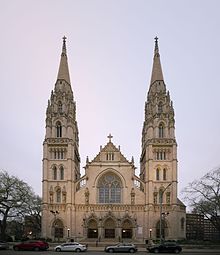Cathedral of Saint Paul (Pittsburgh, Pennsylvania)
| Saint Paul Cathedral | |
|---|---|
 |
|
| 40°26′50.63″N 79°56′59.42″W / 40.4473972°N 79.9498389°WCoordinates: 40°26′50.63″N 79°56′59.42″W / 40.4473972°N 79.9498389°W | |
| Location | 108 N. Dithridge St. Pittsburgh, Pennsylvania |
| Country | United States |
| Denomination | Roman Catholic Church |
| Weekly attendance | 3000 |
| Website | stpaulpgh |
| History | |
| Founded | 1834 |
| Architecture | |
| Architect(s) | Egan and Prindeville |
| Style | Gothic Revival |
| Completed | 1906 |
| Construction cost | US$1.1 million (1906) or US$27,809,444.15 (2016) |
| Specifications | |
| Height | 247 feet (75 m) |
| Number of spires | Two |
| Materials | Limestone |
| Administration | |
| Diocese | Pittsburgh |
| Clergy | |
| Bishop(s) | Most Rev. David A. Zubik |
| Rector |
Rev. Kris D. Stubna |
| Part of | Schenley Farms Historic District (#83002213) |
| Significant dates | |
| Added to NRHP | July 22, 1983 |
| Designated PHLF | 1975 |
Rev. Kris D. Stubna
Saint Paul Cathedral is the mother church of the Roman Catholic Diocese of Pittsburgh in Pittsburgh, Pennsylvania. St. Paul's parish was established in 1834. When the diocese was established in 1843 St. Paul's Church was chosen as the cathedral. The first two St. Paul Cathedrals were located on Grant Street downtown. As the downtown area was claimed by industries, the residential areas shifted to other areas of the city. St. Paul's property was sold to the industrialist Henry Clay Frick. The present Gothic Revival structure was designed by Egan and Prindeville of Chicago and completed in 1906. They used Cologne Cathedral as their inspiration. Philadelphia contractor Thomas Reilly built the new cathedral in the Oakland neighborhood. The pipe organ was provided by Andrew Carnegie. The cathedral serves the spiritual needs of approximately 3,000 worshipers. It became a contributing property in the Schenley Farms Historic District on the National Register of Historic Places in 1983.
Cathedral interior
Pipe organ
Altar and reredos
Cathedra
Ambo
...
Wikipedia

